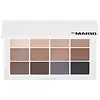Makeup by Mario Master Mattes Eyeshadow Palette The Neutrals Versus Tarte Tartelette Amazonian Clay Eyeshadow Palette
What's inside
What's inside
 Key Ingredients
Key Ingredients

 Benefits
Benefits

 Concerns
Concerns

 Ingredients Side-by-side
Ingredients Side-by-side

Talc
AbrasiveZinc Stearate
Cosmetic ColorantHdi/Trimethylol Hexyllactone Crosspolymer
Triethoxycaprylylsilane
Caprylic/Capric Triglyceride
MaskingDimethicone
EmollientCaprylyl Glycol
EmollientEthylhexylglycerin
Skin ConditioningAlumina
AbrasiveGlycerin
HumectantSilica
AbrasiveTocopherol
AntioxidantCI 77891
Cosmetic ColorantIron Oxides
CI 77163
Cosmetic ColorantCI 77742
Cosmetic ColorantCI 19140
Cosmetic ColorantKaolin
AbrasiveCI 75470
Cosmetic ColorantCI 77007
Cosmetic ColorantCI 77499
Cosmetic ColorantCI 77266
Cosmetic ColorantTalc, Zinc Stearate, Hdi/Trimethylol Hexyllactone Crosspolymer, Triethoxycaprylylsilane, Caprylic/Capric Triglyceride, Dimethicone, Caprylyl Glycol, Ethylhexylglycerin, Alumina, Glycerin, Silica, Tocopherol, CI 77891, Iron Oxides, CI 77163, CI 77742, CI 19140, Kaolin, CI 75470, CI 77007, CI 77499, CI 77266
Talc
AbrasiveMica
Cosmetic ColorantSilica
AbrasiveBoron Nitride
AbsorbentZinc Stearate
Cosmetic ColorantEthylhexyl Palmitate
EmollientSodium Dehydroacetate
PreservativePhenoxyethanol
PreservativeSorbic Acid
PreservativeVanillin
MaskingCaprylic/Capric Triglyceride
MaskingVanilla Planifolia Fruit Extract
Skin ConditioningKaolin
AbrasiveMagnesium Aluminum Silicate
AbsorbentMontmorillonite
AbsorbentCI 75470
Cosmetic ColorantCI 77891
Cosmetic ColorantCI 77742
Cosmetic ColorantIron Oxides
CI 77007
Cosmetic ColorantCalcium Sodium Borosilicate
Tin Oxide
AbrasiveCI 77163
Cosmetic ColorantTalc, Mica, Silica, Boron Nitride, Zinc Stearate, Ethylhexyl Palmitate, Sodium Dehydroacetate, Phenoxyethanol, Sorbic Acid, Vanillin, Caprylic/Capric Triglyceride, Vanilla Planifolia Fruit Extract, Kaolin, Magnesium Aluminum Silicate, Montmorillonite, CI 75470, CI 77891, CI 77742, Iron Oxides, CI 77007, Calcium Sodium Borosilicate, Tin Oxide, CI 77163
Ingredients Explained
These ingredients are found in both products.
Ingredients higher up in an ingredient list are typically present in a larger amount.
This ingredient is an emollient, solvent, and texture enhancer. It is considered a skin-softener by helping the skin prevent moisture loss.
It helps thicken a product's formula and makes it easier to spread by dissolving clumping compounds.
Caprylic Triglyceride is made by combining glycerin with coconut oil, forming a clear liquid.
While there is an assumption Caprylic Triglyceride can clog pores due to it being derived from coconut oil, there is no research supporting this.
Learn more about Caprylic/Capric TriglycerideCi 75470 is a bright-red pigment. It is AKA carmine.
Carmine is derived from insects such as the cochineal beetle. This ingredient has been used as a natural dye for over 2000 years.
This pigment is called Ultramarine blue lazurite. It gives a saturated blue color, but can be used to create other colors as well.
According to the manufacturer, it is usually made from kaolin, sodium sulfate, sodium carbonate, sulfur, and charcoal.
This synthetic powder is used to add a pearly/white color in cosmetics.
This ingredient is used to add a violet color to cosmetics.
It is created by reacting phosphoric acid, ammonium dihydrogen orthophosphate, and manganese dioxide.
Ci 77891 is a white pigment from Titanium dioxide. It is naturally found in minerals such as rutile and ilmenite.
It's main function is to add a white color to cosmetics. It can also be mixed with other colors to create different shades.
Ci 77891 is commonly found in sunscreens due to its ability to block UV rays.
Learn more about CI 77891Kaolin is a clay. It is used for oil control and to help minimize pores. Like other clays, kaolin has the ability to absorb excess sebum or oil. This can help clean out pores and mattify the skin.
Some types of kaolin may have exfoliating properties. When water is added to kaolin, it becomes a paste with small abrasive particles.
Most kaolin is a white color, but may be pink/orange/red depending on where it comes from.
The name 'kaolin' comes from a Chinese village named 'Gaoling'. Kaolin clay comes from rocks rich in kaolinite. Kaolinite, the mineral, has a silicate layered structure. Kaolinite is formed from chemical weathering of aluminum siilicate minerals.
Besides skincare, kaolin is commonly used to make glossy paper, in ceramics, toothpaste, and as medicine to soothe stomach issues.
Learn more about KaolinSilica, also known as silicon dioxide, is a naturally occurring mineral. It is used as a fine, spherical, and porous powder in cosmetics.
Though it has exfoliant properties, the function of silica varies depending on the product.
The unique structure of silica enhances the spreadability and adds smoothness, making it a great texture enhancer.
It is also used as an active carrier, emulsifier, and mattifier due to its ability to absorb excess oil.
In some products, tiny microneedles called spicules are made from silica or hydrolyzed sponge. When you rub them in, they lightly polish away dead skin layers and enhance the penetration of active ingredients.
Learn more about SilicaTalc is a clay mineral. It helps absorb moisture and improve the texture of products. Like other types of clay, Talc can have a slight exfoliating effect on skin. Talc can be added to increase the volume of products.
Some Baby powders are made by combining talc with corn starch. The word "talc" comes from Latin and originates from Arabic. Talc is a mineral commonly found throughout the world.
If you have any concerns about using talc, we recommend checking out the FDA's official page.
Learn more about TalcZinc Stearate is the metal salt of stearic acid. It is a white solid used to bind, thicken, and lubricate products.
This ingredient is common in powder makeup, where it helps keep the powder together.
Zinc Stearate is hydrophobic and repels water.
This ingredient can be sourced from non-animal or animal sources. It is best to reach out to the brand to see where they source this ingredient from.
Learn more about Zinc StearateThis ingredient is a combination of red, black, and yellow iron oxide pigments. This combination of colors is usually found in foundation, because it results in a "skin" color.